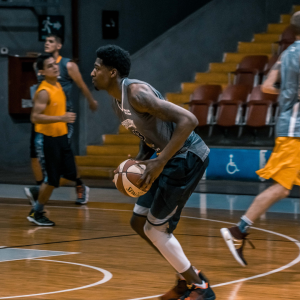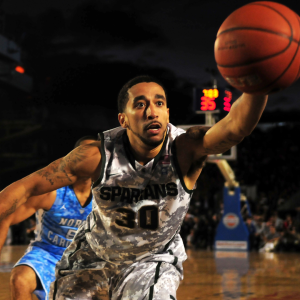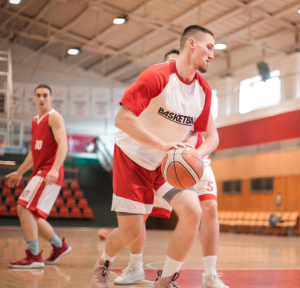Navigating the Court: A Guide to Common Basketball Injuries and How to Stay in the Game
 Basketball is an exhilarating sport that demands speed, agility, and teamwork. As fans, we celebrate the awe-inspiring dunks, precision three-pointers, and strategic plays that define the game. However, the fast-paced nature of the game exposes players to various injuries.
Basketball is an exhilarating sport that demands speed, agility, and teamwork. As fans, we celebrate the awe-inspiring dunks, precision three-pointers, and strategic plays that define the game. However, the fast-paced nature of the game exposes players to various injuries.
At the Orthopaedic Hospital of Wisconsin, basketball season also means we see an increase in sprains, strains, and other common basketball injuries. Whether you’re a seasoned player or a weekend warrior, understanding common basketball injuries is crucial for preventing and managing potential setbacks.
In this blog, OHOW physical therapist Matt Pitton, PT, DPT, explores some of the most prevalent basketball injuries, their causes, symptoms, and how to stay on the court and minimize the risk of injury.
-
Ankle Sprains: The Achilles’ Heel of Hoops
Almost everyone has experienced injuring or rolling their ankle. One of the most common ankle injuries includes an ankle sprain, where the ligaments of the ankle joints are stretched or torn. This injury can be painful and reduce your mobility.
Causes: Sharp cuts, sudden stops, and changes in direction can lead to ankle sprains, one of the most frequent injuries in basketball.
Symptoms: Swelling, pain, and difficulty bearing weight on the affected ankle.
Prevention and Treatment: Strengthening exercises, proper footwear, and taping or bracing techniques can reduce the risk. If injured, R.I.C.E (Rest, Ice, Compression, Elevation) and rehabilitation exercises are crucial for recovery.
-
Knee Injuries: Guarding the Joints
 The knee contains four major ligaments that connect the femur (thigh bone) to the tibia (shin bone). These ligaments allow for coordination function and stability of the knee joint. With the swift movements required by players, an individual of any age or fitness level is at risk of injuring the structures of the knee.
The knee contains four major ligaments that connect the femur (thigh bone) to the tibia (shin bone). These ligaments allow for coordination function and stability of the knee joint. With the swift movements required by players, an individual of any age or fitness level is at risk of injuring the structures of the knee.
Causes: Jumping, pivoting, and abrupt changes in direction put significant stress on the knees, making them susceptible to injuries like ACL tears and patellar tendinitis.
Symptoms: Pain, swelling, instability, and difficulty bending or straightening the knee.
Prevention and Treatment: Strengthening the muscles around the knee, using proper landing techniques, and maintaining flexibility are key prevention strategies. Physical therapy and sometimes surgery may be necessary for recovery.
-
Jam-packed: Finger and Hand Injuries
 The hand is very vulnerable to injuries while playing basketball. Whether from dribbling, catching the ball, or catching yourself from a fall, the fingers and hands can take on the brunt of a traumatic injury. A finger or hand injury may result in immediate pain, potential swelling, and reduced mobility. Thankfully, these injuries are rarely severe.
The hand is very vulnerable to injuries while playing basketball. Whether from dribbling, catching the ball, or catching yourself from a fall, the fingers and hands can take on the brunt of a traumatic injury. A finger or hand injury may result in immediate pain, potential swelling, and reduced mobility. Thankfully, these injuries are rarely severe.
Causes: Jammed fingers, fractures, and dislocations often occur during rebounds, passes, or attempts to steal the ball.
Symptoms: Pain, swelling, bruising, and difficulty gripping objects.
Prevention and Treatment: Wearing protective gear, like finger splints or tape, can reduce the risk. Rest, ice, and gentle exercises aid in recovery.
-
Back Injuries: Slam Dunked by Overuse
Like any high-impact sport, basketball can put you at risk of a back injury. If you’re shooting your shot or helping to pass the ball to your teammates, frequent running, jumping, and quick changes in direction may lead to an overuse injury when you don’t incorporate preventative measures.
Causes: Repetitive jumping, running, and sudden twists contribute to back injuries, including muscle strains and stress fractures.
Symptoms: Persistent pain, stiffness, and limited range of motion.
Prevention and Treatment: Core strengthening exercises, maintaining good posture, and proper warm-up are essential for preventing back injuries. Rest and physical therapy are key components of recovery.
-
Concussions: Guard Your Head
A concussion is a mild brain injury that can occur from a direct blow to the head or hitting the ground violently. If an athlete sustains a blow to the head on the court, it’s vital to recognize concussion signs and symptoms right away.
Causes: Collisions with other players, falls, or being hit by the ball can result in concussions.
Symptoms: Headache, dizziness, confusion, and sensitivity to light or noise.
Prevention and Treatment: Wearing protective headgear, following the rules of the game, and reporting symptoms promptly are crucial for prevention. Rest and medical evaluation are necessary for recovery. Physical therapy may be utilized for concussion rehab to return to play.
 While basketball injuries are an unfortunate reality, players can take proactive steps to reduce their risk and promote a safe and enjoyable playing experience. By incorporating proper warm-up routines, strengthening exercises, and maintaining overall physical fitness, players can guard against common basketball injuries and continue to embrace the thrill of the game.
While basketball injuries are an unfortunate reality, players can take proactive steps to reduce their risk and promote a safe and enjoyable playing experience. By incorporating proper warm-up routines, strengthening exercises, and maintaining overall physical fitness, players can guard against common basketball injuries and continue to embrace the thrill of the game.
Remember, a healthy body and smart playing techniques are your best defense on the court. If you experience persistent pain that is keeping you on the bench, seek the assistance of a professional.
Our team at Orthopaedic Hospital of Wisconsin is here to help! Make an appointment with our trained orthopedic specialists to assess the situation and figure out the right treatment course. Avoid common basketball injuries by taking the proper precautions before, during, and after the game.

